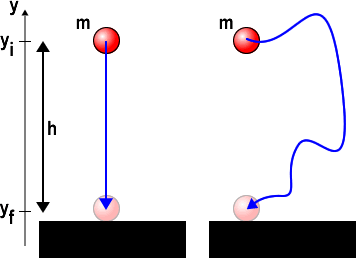"Music is a hidden practice of the soul, which does not know that it is doing mathematics."
-- Leibniz
I still don't understand why these assignments take you so much longer than the tens of thousands of mostly American first year Physics students who have done these questions over the past few years. Your overall performance in terms of percent correct, number of wrong answers, number of hints, etc. is virtually identical.
If you have a conflict with this day and time contact Dr. Savaria in MP901A immediately. |
We will be providing you with many more details about the test soon.
| Due in the Drop Box for your tutorial group by Monday, October 18, by 5 PM. |
Today we covered Chapter 7 Potential Energy of the textbook, but did not follow the textbook very closely. Here is an outline of how we discussed this material.
First, you should be aware that the whole concept of potential energy is in some sense just an abstraction of the idea of work. Although certainly a useful way to think about some mechanics problems, the concept is crucial for what comes in the third quarter of PHY138.
We begin by considering the work done by gravity on an object of mass m that moves only under the influence of gravity. It begins at a height yi with some speed vi, and moves to a height yf where it has a speed vf. The total vertical distance it falls is h. The first realisation is that the work done by gravity is independent of the path, that it depends only on the initial vertical position and the final vertical position independent of how it got there. From the work-kinetic energy theorem we know that the quantity:
is the same value for all values of y. |
 |
Forces whose work is independent of the path but depends only on the initial and final positions are called conservative. Another conservative force is the one exerted on a mass by a spring.
For the gravitational problem we define the potential energy U as equal to the quantity m g y. We call it the potential energy because it represents the potential for work to be done on the mass by gravity. Of course, as the work is actually done by gravity the potential for it to do work goes down, so the work actually done is the negative of the change in potential energy:
W = -
U
We can say that the mechanical energy
Emech = U + K
is conserved for this situation.
Notice that in the above figure we did not specify the origin of the coordinate system, i.e. the point at which y = 0. We can, of course, choose the zero to be anywhere that we wish. For example:
For all three of these choices, and in fact for any choice, the mechanical energy is still conserved.
Thus, we conclude that:
We can choose any position in space to be defined as having zero potential energy.
Of course, as usual with choices of a coordinate system, some choices of the zero of potential energy are mathematically easier than others.
Finally, there are 2 small matters to discuss:
| We asked a question about the "pegged pendulum" and did a demonstration. Most of the class got the question correct: it rises to height B. |
In class we also used an air track out of the laboratory for a demonstration. Some of you will be doing the experiment using this apparatus this term, and the apparatus will also be available next term. The Guide Sheet for the experiment is in your lab manual.